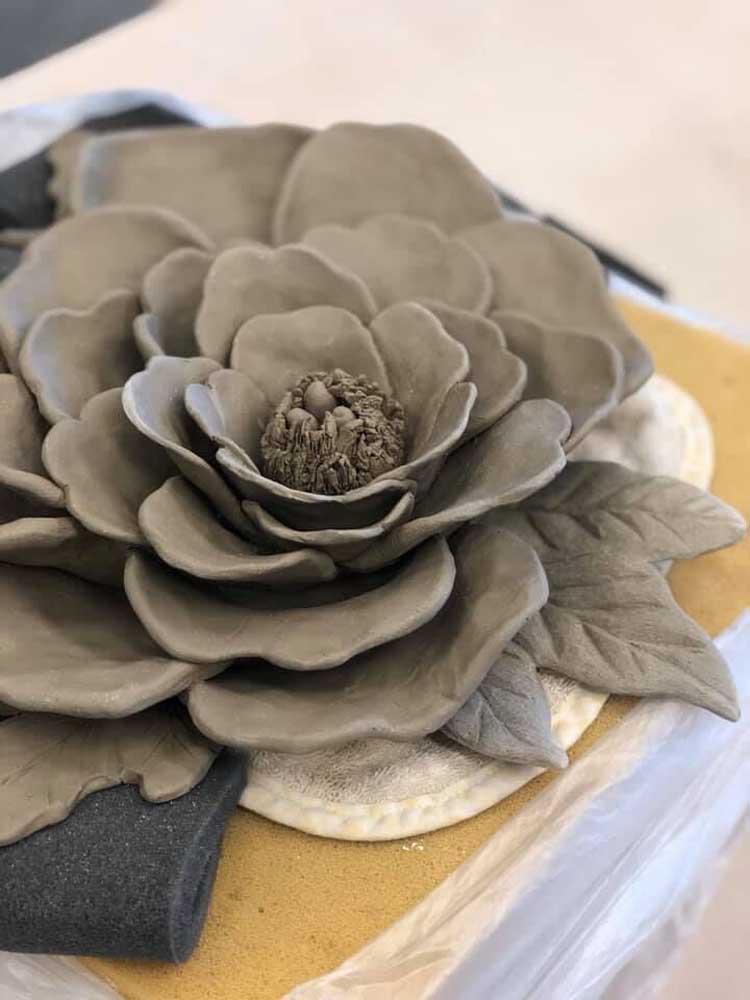Sponsored Content
Sparking creativity in a remote classroom
Published 11:31 am Wednesday, December 2, 2020

- Art in bloom. Clay sculpture by Jordan Dickinson.
A newly made, still-soft inlaid clay dish suddenly appears on the screen, making its Zoom debut. It’s the show-and-tell portion of an intermediate ceramics class at Central Oregon Community College (COCC), and student Linda Harp, seated at her home computer, is holding up a recent work for her classmates and instructor to see. With the studio component of the class presently on pause for safety precautions, workspaces and artists are scattered. But the creativity abounds.
“The art is born from when the artist is in their zone,” said Shin Yeon Jeon, instructor of the remote wheel-throwing and hand-building class. “At home, they can immerse themselves — no distractions.”
Students can borrow equipment from COCC; clay is purchased through the college’s bookstore or a local supplier. During class, students watch demos, discuss techniques and meet one-on-one with their instructor in the virtual classroom. The ceramics program’s Facebook page doubles as an online gallery and learning space, a place to unite in art. And twice a week the students are able to visit the Bend campus studio (with masks and gloves) to glaze their projects and prep pieces for firing.
While fine arts offerings at COCC have had to adjust since the onset of the coronavirus, many classes remain available. The current schedule features remotely taught subjects in drawing, graphic design, digital photography, music theory and the history of rock music, among others. For winter term, which begins Jan. 4, COCC plans to open up a selection of hybrid art classes — partially remote, partially in-person — in subjects like metal work, 3D design, and, yes, ceramics.
Virtual learning requires that both students and faculty get creative with the very process of creativity. For student Jordan Dickinson of Bend, that’s meant fitting a pottery wheel into a corner of her bedroom, using plastic sheeting and a tarp to protect the floor and walls. Her projects — including a recent series of sculpted pumpkins rendered with human faces — are stored in a communal room in the house she shares with roommates.
“It’s been a bit difficult not having as much studio space as I’m used to,” Dickinson acknowledged. “But I’m super grateful that I have a space at home where I can still work on the wheel and have a little studio of my own. Having access to a throwing wheel any time of the day has been amazing and has enabled me to work whenever inspiration hits.”
For this emerging artist, who’s working toward an Associate of Arts Oregon Transfer degree at COCC, with a goal of earning a bachelor’s degree, the speedbumps of learning in a COVID world have produced some unexpected advantages.
“I like that we talk more, we talk about other artists and movements,” she said, noting that there can be inherent, ongoing distractions to a communal work environment. “Shin Yeon is an instructor who is truly passionate about what she does,” she added, “and has really gone above and beyond to make sure that her students are getting the best education possible.”
Adaptability is just as important as passion in the teaching environment these days. Michael Gesme, the chair of COCC’s fine arts department, likens COVID-era instruction to the approach of a proven improviser. “It’s ‘MacGyver’ magic in the education world,” he said. “Our instructors are committing extensive amounts of time and energy to develop effective methodologies and teaching tools to deliver information — things that, in person, can be conveyed with a glance or quick comment.”
Some of those methods are on display in a recent remote “Music Fundamentals” class, as professor and composer Jim Knox, standing at a keyboard, plays a musical triad — three notes that function together as a chord — from British composer Gustav Holst. Then, quickly jumping from the sounds of a century ago to current pop culture, he samples another triad: the opening notes of “The Simpsons” theme song.
“When you stack notes together,” Knox said, pausing to scrawl them on the screen-shared music sheet with a PDF drawing tool, “triads are a specific type of chord.”
As the instructor multi-tools his way through the day’s lesson, his 12 students — including Julie Merrick (who hopes to be a music producer) and Evelyn Donaldson (a singer in COCC’s Cascade Chorale, which, incredibly, Knox still leads virtually each week) — are finding an engaging learning setting. “Jim is an amazing teacher,” said Donaldson.
From minor thirds to glazing techniques, art — and inspiration — keeps on thriving, even remotely, at COCC. “Art is a lifelong adventure of learning and creating,” shared ceramics student Jordan Dickinson. “And I am so excited for what the future brings.”
COCC’s winter term starts Jan. 4. Explore your own creative options at cocc.edu or by calling 541-383-7700.








